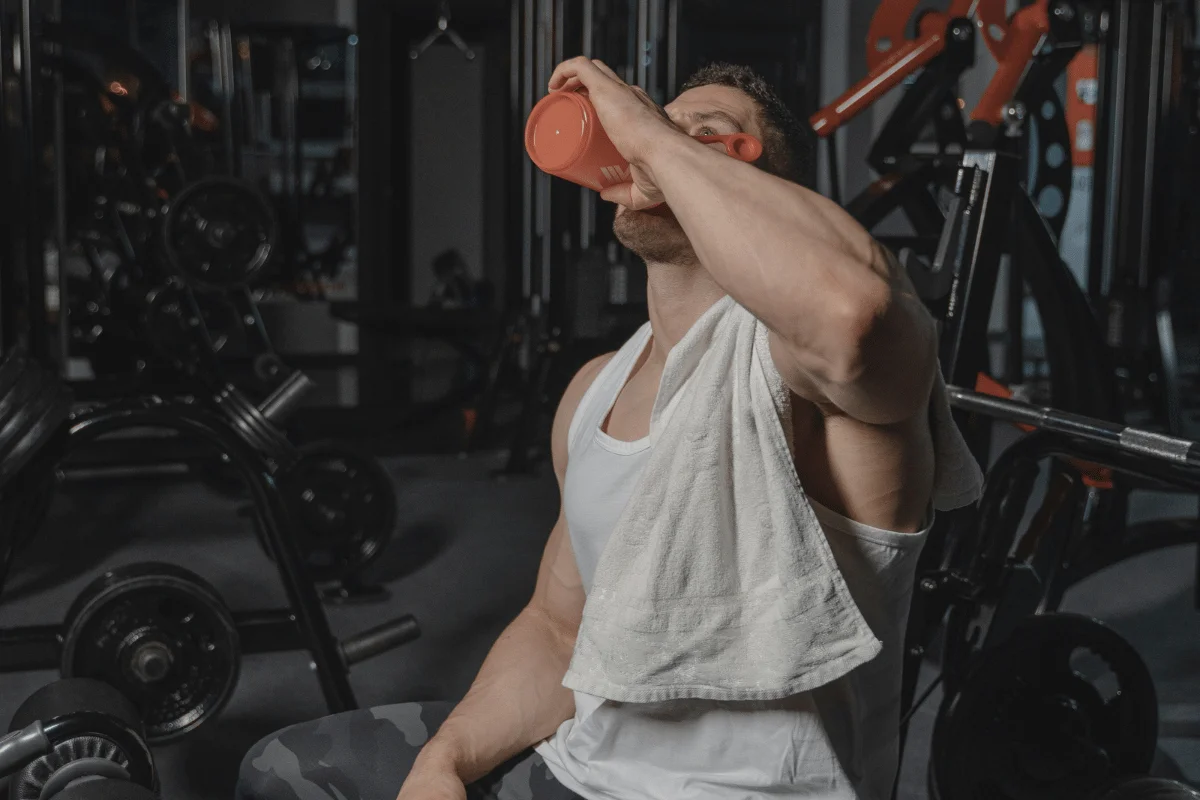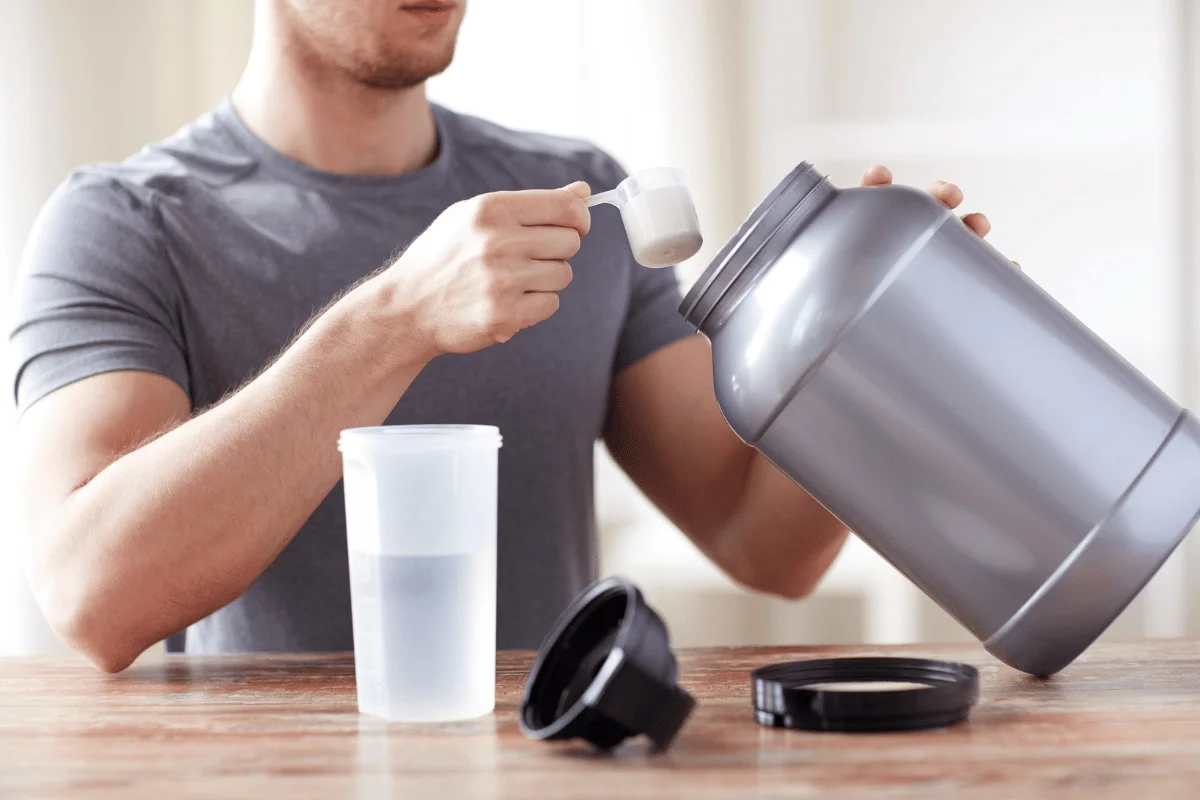[Disclaimer: This article is for informational purposes only and does not constitute medical advice. Always consult with a qualified healthcare provider before starting any peptide therapy.]
Building muscle requires dedication and consistent training, but many bodybuilders experience plateaus even with their best efforts in the gym. Peptides – small chains of amino acids that occur naturally in the body – have gained attention as a potential way to enhance muscle growth and recovery.
Research shows that certain peptides for bodybuilding can help improve muscle growth when combined with proper resistance training and nutrition. The effectiveness varies between individuals, but studies have documented improvements in lean muscle mass and recovery times.
This guide explores evidence-based information about peptides commonly used in bodybuilding, including proper usage guidelines and important safety considerations.
Key Takeaways
- Peptides are natural amino acid chains that support muscle growth through specific biological pathways, offering a more targeted approach than traditional supplements
- Unlike anabolic steroids, peptides work with the body’s natural growth mechanisms, resulting in fewer adverse effects while still promoting muscle development
- Research shows peptides can accelerate muscle recovery, enhance fat loss, and improve protein synthesis when combined with proper training and nutrition
- Medical supervision and proper sourcing are essential for safe peptide use, as quality and administration protocols significantly impact their effectiveness and safety
TL;DR – The Safest Peptides for Bodybuilding
|
Peptide |
Primary Benefits |
Key Features |
|
Ipamorelin |
Growth hormone stimulation |
Mimics ghrelin to naturally stimulate GH release. Works more selectively than similar compounds. Effectively supports muscle growth and recovery. Shows promise for improving overall body composition. |
|
CJC-1295 |
Extended-action muscle growth |
Provides long-lasting effects in the body. Naturally stimulates both GH and IGF-1 production. Significantly improves recovery time and sleep quality. Shows minimal side effects in healthy adults. |
|
MK-677 |
Growth hormone secretion |
Effectively increases lean muscle mass production. Creates positive nitrogen balance for growth. Offers convenient oral administration method. Helps preserve muscle while reducing body fat. |
|
BPC-157 |
Muscle healing |
Speeds up healing across muscles, tendons and ligaments. Increases sensitivity to growth hormone in tissues. Provides protection against various forms of muscle damage. Demonstrates excellent safety profile in studies. |
|
IGF-1 LR3 |
Direct muscle growth |
Directly enhances protein synthesis in muscle tissue. Actively prevents breakdown of muscle mass. Promotes fusion of muscle fibers for growth. Activates key pathways for muscle development. |
|
Collagen Peptides |
Joint support |
Significantly reduces exercise-related joint pain. Improves overall joint function and stability. Increases natural collagen production in the body. Particularly effective for active individuals. |
What Are Peptides and How Do They Work?
Peptides are short chains of amino acids that act as signaling molecules across various biological systems, including the endocrine, nervous, and immune systems1.
These naturally occurring compounds, typically containing between two to fifty amino acids linked through peptide bonds, are smaller and more targeted than complete proteins.
Through their signaling capabilities, peptides can regulate gene expression, protein synthesis, and influence DNA interactions and epigenetic mechanisms.
In the human body, peptides play vital roles in muscle growth, fat metabolism, and post-exercise recovery. While the body produces many peptides endogenously, supplemental forms have garnered attention for their potential to enhance muscle mass and strength gains more effectively than natural production alone.
These supplements work synergistically with growth hormone and IGF-1 (insulin-like growth factor 1) to create an optimal environment for muscle development. Different peptide variants target specific aspects of muscle building and recovery through distinct biological pathways.
Research indicates that certain peptides can promote accelerated healing of muscle tissue2 while simultaneously reducing body fat and preserving lean mass. This selective action occurs through the activation of specific cellular signals that enhance protein synthesis and facilitate muscle repair.
Peptides act as the body’s natural messengers for enhanced muscle growth and accelerated recovery.
The targeted nature and relative safety of peptides have made them particularly valuable to athletes and bodybuilders seeking to increase muscle mass without the severe side effects associated with anabolic steroids.
Recent advances in peptide science have yielded more stable and effective formulations, further increasing their appeal among fitness enthusiasts. These developments have enhanced both the bioavailability and specificity of peptide supplements, allowing for more precise targeting of desired physiological outcomes.
Peptides vs. Steroids: Why Natural Amino Chains Are Safer for Bodybuilding
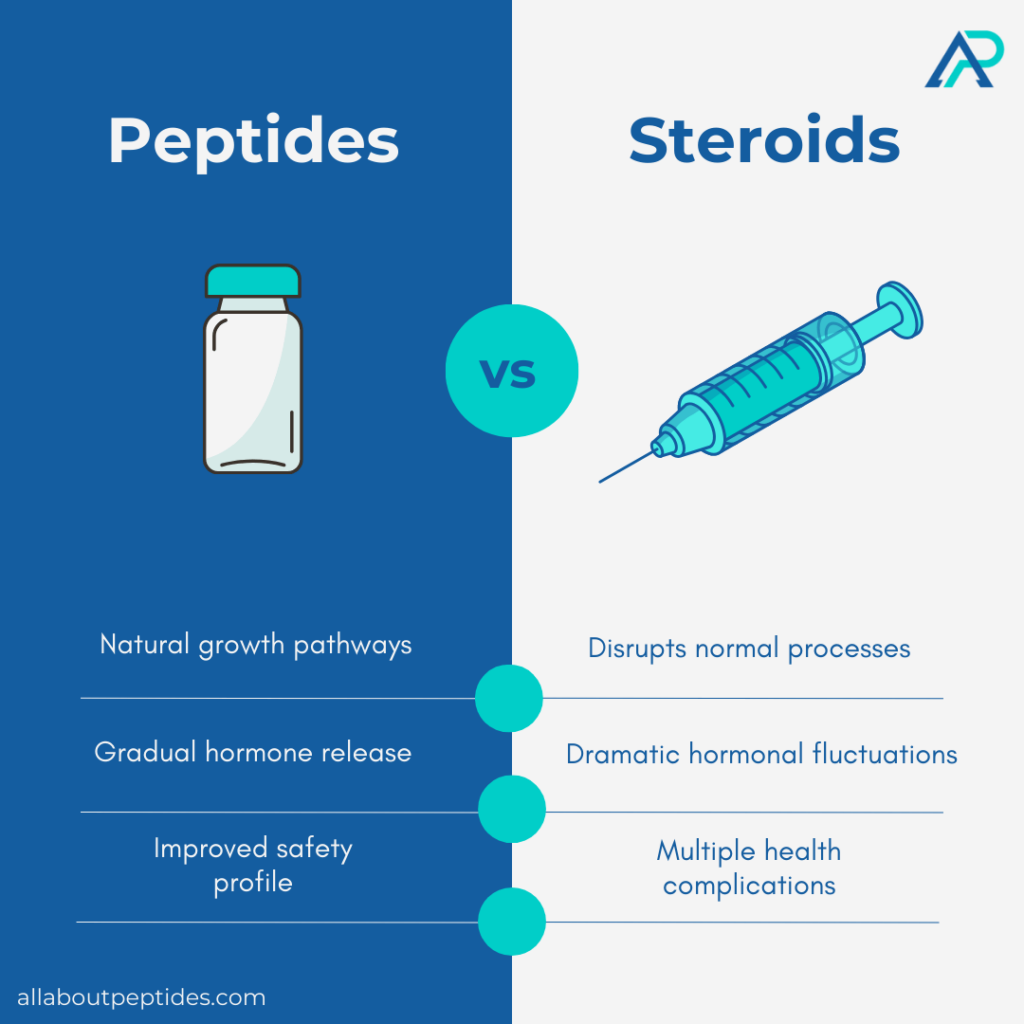
Peptides offer a promising alternative to anabolic steroids for muscle development by working through the body’s natural growth pathways.
Unlike synthetic steroids, which can disrupt normal physiological processes and cause severe organ damage3, peptides function through specific amino acid chains that target muscle growth mechanisms.
This targeted approach allows peptides to stimulate muscle development while minimizing the risk of serious side effects commonly associated with steroid use, such as liver dysfunction, cardiovascular complications, and hormonal imbalances.
The key advantage of peptides lies in their ability to promote gradual growth hormone release, allowing the body to adapt naturally to increased muscle development. This measured physiological response contrasts sharply with the dramatic hormonal fluctuations caused by steroids, which can lead to mood disturbances, severe acne, and organ strain.
Due to their improved safety profile and effectiveness, medical professionals increasingly recommend peptides as an alternative for individuals seeking muscle gains through biochemical enhancement.
Benefits of Peptides for Muscle Growth
Peptides help build muscle in several ways: they may speed up recovery after workouts, assist with burning fat, and support the growth of lean muscle tissue.
Understanding how peptides work can help explain their potential benefits for bodybuilding and strength training.
May Support Muscle Growth and Repair
When we lift weights or exercise intensely, our muscle fibers develop microscopic tears – a normal part of getting stronger. Peptides can help orchestrate the repair process by signaling the body to increase muscle protein synthesis, the biological process where new muscle tissue is built.
Some peptides work by stimulating the release of growth hormone, while others directly activate muscle stem cells. This coordinated response helps create stronger, larger muscle fibers. Research shows that specific peptides may also help distribute nutrients to muscle tissue more effectively, providing the building blocks needed for growth and recovery4.
Can Accelerate Recovery Times
One of the most frustrating aspects of training is dealing with muscle soreness and long recovery periods between workouts. Studies suggest that certain peptides can help reduce inflammation and speed up the healing of damaged muscle tissue.
They appear to work by increasing blood flow to injured areas and activating special repair cells called fibroblasts5. This enhanced recovery process means athletes may be able to return to training sooner and maintain a more consistent workout schedule.
Some peptides have even shown promise in helping prevent common overuse injuries by strengthening connective tissues.
Promote Fat Loss and Muscle Retention
Losing fat while maintaining muscle mass is one of the biggest challenges in fitness. Research indicates that some peptides can help the body become more efficient at using stored fat for energy while protecting lean muscle tissue.
They appear to work by improving insulin sensitivity and boosting the production of enzymes that break down fat cells. This dual action may help achieve a more defined, muscular appearance.
Some peptides have been shown to increase the number of mitochondria in muscle cells6, potentially improving endurance and overall metabolic health.

Top Safe Bodybuilding Peptides for Muscle Growth in 2025
The fitness market offers several safe and effective peptides that support muscle growth in 2025. These natural compounds work with your body’s systems to boost muscle gains, speed up recovery, and improve overall athletic performance.
Ipamorelin: The Growth Hormone Peptide
Ipamorelin is a growth hormone secretagogue that mimics ghrelin, stimulating the release of growth hormone (GH) from the pituitary gland. This makes it interesting for bodybuilders who want to promote muscle growth and improve their body composition.
When using ipamorelin, it effectively signals the body to release more growth hormone, which helps muscles grow and recover after exercise. Unlike similar compounds such as GHRP-6, ipamorelin works more precisely in the body. It increases growth hormone without raising levels of stress hormones like cortisol and ACTH7. This selective action helps maintain muscle mass with fewer unwanted effects.
Research in animals has shown that long-term ipamorelin use leads to weight gain, mainly because of how it triggers growth hormone release. Growth hormone helps build muscle tissue and can improve the ratio of muscle to fat in the body8.
However, ipamorelin may also increase body fat through other pathways that don’t involve growth hormone. For example, it can boost appetite and food intake9. This could be a consideration for bodybuilders looking to bulk up, although it may require careful dietary management to avoid excessive fat gain.
Beyond its effects on muscle and fat, ipamorelin has shown another interesting benefit in animal studies: it helps bones grow longer and stronger. These bone-strengthening effects likely come from both direct action on bone tissue and indirect effects through increased growth hormone levels10.
CJC-1295: The Extended-Action Muscle Promoter
CJC-1295 is a synthetic growth hormone-releasing hormone (GHRH) analog that has several benefits for bodybuilding.
CJC-1295 helps in muscle enhancement and fat loss. It stimulates the release of GH and IGF-111, which are crucial for muscle growth and repair. This can lead to increased muscle mass and reduced body fat, making it popular among bodybuilders.
One of the significant benefits of CJC-1295 is its long-lasting effect. Unlike other growth hormone-releasing peptides, CJC-1295 has a prolonged half-life, meaning it stays active in the body for a longer period. This allows for less frequent dosing while maintaining its effectiveness in stimulating GH and IGF-I production.
CJC-1295 is also associated with improved recovery from workouts and better sleep quality. Enhanced recovery is crucial for bodybuilders as it allows them to train more frequently and intensely. Better sleep contributes to overall health and well-being, which can indirectly support bodybuilding goals.
Studies have shown that CJC-1295 is generally safe and well-tolerated in healthy adults. It does not cause significant adverse reactions, making it a viable option for those looking to enhance their bodybuilding results without severe side effects.
Expert Insight: Bodybuilders often experience a powerful synergy between CJC-1295 and Ipamorelin, with many claiming the duo unlocks enhanced muscle growth and recovery.
MK-677: The Growth Hormone Secretagogue
One of the primary benefits of MK-677 for bodybuilders is its ability to increase lean muscle mass. Research indicates that MK-677 can lead to a significant increase in fat-free mass12, which is mostly muscle, without the need for injections, as it is taken orally.
MK-677 has been shown to improve nitrogen balance, which is essential for muscle growth13. A positive nitrogen balance indicates that the body is in an anabolic state, meaning it is building more muscle than it is breaking down. This effect can help bodybuilders maintain and increase muscle mass, especially during periods of caloric restriction.
MK-677 can also increase energy expenditure, which may help in reducing body fat while preserving muscle mass. This is beneficial for bodybuilders who are looking to achieve a leaner physique while maintaining their muscle gains.
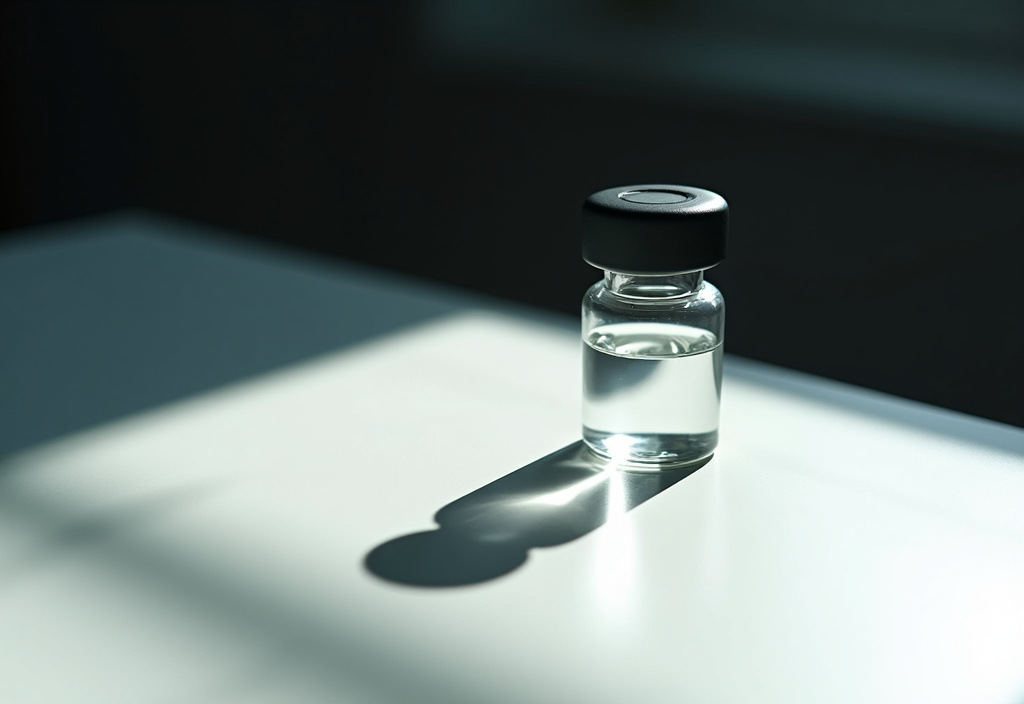
BPC-157: The Muscle Healing Peptide
BPC-157 has been found to help heal muscles, tendons, and ligaments14. This is important for bodybuilders who often experience injuries from intense workouts. The compound helps in the recovery of muscle injuries and can speed up the healing process, allowing athletes to return to training more quickly.
BPC-157 can increase the expression of growth hormone receptors in tendon cells15. This means that it can enhance the effects of growth hormone, which is crucial for muscle growth and repair.
The compound has also been shown to protect against muscle damage caused by various factors, such as hyperkalemia (high potassium levels) and the use of certain muscle relaxants like succinylcholine16. This protective effect can help maintain muscle function and prevent injuries during intense physical activities.
BPC-157 is considered to have a very safe profile, with no lethal dose identified. It can be administered in various ways, such as orally or through injections, making it a versatile option for those looking to enhance their recovery and performance.
IGF-1 LR3: Direct Stimulation of Muscle Hypertrophy
IGF-1 LR3 is crucial for muscle growth as it enhances protein synthesis in muscle cells. It activates pathways like PI3K/Akt/mTOR17, which are essential for increasing muscle size and strength.
IGF-1 LR3 helps prevent muscle atrophy, which is the loss of muscle mass. It does this by inhibiting pathways that lead to muscle breakdown, such as the ubiquitin-proteasome system and autophagy.
The peptide also increases the recruitment of reserve cells for muscle fiber fusion18, which contributes to muscle hypertrophy. This process involves adding more nuclei to muscle fibers, enhancing their growth potential.
Collagen Peptides: Joint Health and Recovery
Collagen peptides have been shown to significantly reduce joint pain, especially in young, physically active adults. Studies indicate that specific bioactive collagen peptides can decrease activity-related knee pain, making it easier for individuals to engage in physical activities without discomfort19.
Supplementation with collagen peptides can enhance joint function by promoting the synthesis of collagen and other components of the extracellular matrix20. This leads to better joint stability and functionality, which is particularly beneficial for athletes and those recovering from joint injuries.
How to Use Peptides Safely for Bodybuilding
Proper peptide usage requires careful attention to dosing, timing, and administration methods. While these compounds can support muscle development, following safety protocols is essential for both effectiveness and wellbeing.
Consultation and Medical Supervision
Before starting any peptide regimen, work with a qualified healthcare provider who can assess your individual needs and health status.
They can help determine appropriate peptide types and dosages based on your goals, medical history, and current fitness level. Regular check-ups during peptide use allow for monitoring of progress and potential side effects.
Proper Storage and Handling
Most peptides require refrigeration to maintain their stability and effectiveness. Store them at the recommended temperature (usually between 36-46°F/2-8°C) and away from direct light.
Never use peptides that appear cloudy, discolored, or show signs of contamination. Keep all supplies clean and sterile during preparation and administration.
Dosing and Timing Considerations
Start with the lowest effective dose recommended by your healthcare provider. Dosing schedules vary by peptide type – some require daily administration while others follow specific cycling patterns.
Many peptides work best when taken before bed or post-workout, as these times align with the body’s natural muscle recovery processes. Keep detailed records of your dosing schedule and any effects you notice.
Quality and Sourcing
Only obtain peptides from reputable sources that provide certificates of analysis and quality testing. Avoid purchasing from unverified suppliers or online marketplaces without proper documentation.
The quality and purity of peptides can significantly impact both their safety and effectiveness.
Third-Party Tested, 99% Purity
Order lab-verified peptides from our top recommended vendor.
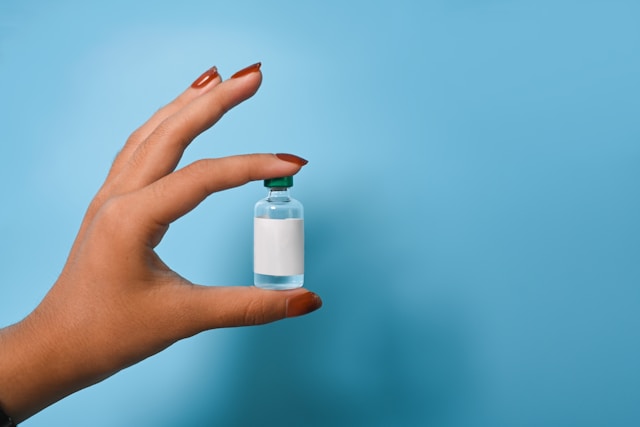
Monitoring and Progress Tracking
Keep detailed records of your peptide usage, training program, diet, and body composition changes. This information helps identify what’s working and allows for informed adjustments to your protocol.
Regular blood work can help ensure your body is responding appropriately and maintaining healthy hormone levels.
Potential Risks and Side Effects of Peptides
While peptides can offer benefits for muscle development, users should be aware of potential risks and adverse effects. Understanding these risks helps inform decisions about peptide use and ensures proper monitoring of side effects.
Common Side Effects
Most users experience mild side effects that typically subside as the body adjusts. These may include:
- Redness and irritation at injection sites
- Increased hunger and water retention
- Tingling or numbness in hands and feet
- Temporary joint pain
- Changes in blood sugar levels
- Fatigue or lethargy during initial use
Cardiovascular Considerations
Some peptides may affect heart function and blood pressure. Users should monitor their cardiovascular health through regular check-ups, especially those with pre-existing heart conditions or high blood pressure.
Changes in heart rate or blood pressure should be reported to healthcare providers immediately.
Hormonal Impact
Peptides can influence the body’s natural hormone production. This may lead to:
- Changes in energy levels and mood
- Alterations in sleep patterns
- Impacts on thyroid function
- Potential suppression of natural growth hormone production
- Changes in insulin sensitivity
Long-Term Health Considerations
Research on the long-term effects of peptide use remains limited. Users should consider:
- Potential impacts on organ function, particularly liver and kidneys
- Changes in bone density and joint health
- Possible effects on immune system function
- Unknown interactions with other medications or supplements
- Risk of developing antibodies to certain peptides
Risk of Contamination
Using unverified peptide sources carries significant risks:
- Presence of harmful impurities or toxic substances
- Incorrect peptide sequences or concentrations
- Bacterial contamination due to improper manufacturing
- Degraded or inactive compounds from poor storage
Special Population Considerations
Certain groups should exercise extra caution or avoid peptide use entirely:
- Individuals with autoimmune conditions
- People with history of cancer or tumor growth
- Pregnant or nursing women
- Those with bleeding disorders
- Individuals with diabetes or blood sugar regulation issues
Signs of Adverse Reactions
Users should seek immediate medical attention if experiencing:
- Severe allergic reactions
- Persistent headaches or vision changes
- Unusual swelling or inflammation
- Severe mood changes or depression
- Irregular heartbeat or chest pain
- Difficulty breathing
Combining Peptides with Nutrition and Exercise
To maximize the benefits of peptide use, a well-structured approach to nutrition and training is essential. This comprehensive strategy helps create an optimal environment for muscle growth and recovery.
Nutrition Fundamentals
A properly designed nutrition plan amplifies peptide effectiveness. Focus on:
- Maintaining adequate protein intake (1.6-2.2g per kg of body weight)
- Timing carbohydrates around training sessions
- Including healthy fats for hormone production
- Staying well-hydrated (minimum 3-4 liters daily)
- Eating frequent, balanced meals to support muscle growth
Strategic Meal Timing
Coordinate meals with peptide administration and training:
- Pre-workout meals should be rich in easily digestible carbs and moderate protein
- Post-workout nutrition within 30 minutes of training
- Evening meals that support overnight recovery and growth
- Small, protein-rich snacks between larger meals
- Adjusting meal timing based on specific peptide protocols
Training Program Design
Structure your training to complement peptide use:
- Include both compound and isolation exercises
- Allow adequate recovery between training sessions
- Incorporate progressive overload principles
- Balance intensity and volume
- Include deload weeks to prevent overtraining
Recovery Optimization
Enhanced recovery supports peptide effectiveness:
- Get 7-9 hours of quality sleep nightly
- Practice stress management techniques
- Include active recovery days
- Use appropriate mobility and stretching protocols
- Monitor training intensity and adjust as needed
Supplement Integration
Coordinate other supplements with peptide protocols:
- Essential amino acids and BCAAs
- Vitamins and minerals for overall health
- Pre-workout supplements for performance
- Recovery supplements
- Timing supplements to avoid interactions
Progress Monitoring
Track various metrics to assess effectiveness:
- Body composition measurements
- Strength progression
- Recovery capacity
- Energy levels
- Sleep quality
- Appetite and digestion
- Progress photos and measurements
Lifestyle Considerations
Optimize other factors that influence results:
- Maintain consistent sleep schedules
- Manage stress levels
- Stay active throughout the day
- Plan rest and recovery periods
- Balance training with other life demands
Takeaway: Safe Peptides for Muscle Growth
Safe use of peptides offers bodybuilders a powerful way to reach their muscle-building goals in 2025. Medical guidance, proper dosage, and high-quality products remain key factors for success with peptide supplementation.
Your fitness journey deserves the right tools, and peptides can serve as valuable allies alongside proper nutrition and training. Smart peptide choices paired with dedication to safety protocols will help you build the physique you want.
References
- Apostolopoulos, V., Bojarska, J., Chai, T. T., Elnagdy, S., Kaczmarek, K., Matsoukas, J., New, R., Parang, K., Lopez, O. P., Parhiz, H., Perera, C. O., Pickholz, M., Remko, M., Saviano, M., Skwarczynski, M., Tang, Y., Wolf, W. M., Yoshiya, T., Zabrocki, J., Zielenkiewicz, P., … Toth, I. (2021). A Global Review on Short Peptides: Frontiers and Perspectives. Molecules (Basel, Switzerland), 26(2), 430. https://doi.org/10.3390/molecules26020430
↩︎ - Cushman, C. J., Ibrahim, A. F., Smith, A. D., Hernandez, E. J., MacKay, B., & Zumwalt, M. (2024). Local and Systemic Peptide Therapies for Soft Tissue Regeneration: A Narrative Review. The Yale journal of biology and medicine, 97(3), 399–413. https://doi.org/10.59249/TKNM3388
↩︎ - Samaha, A. A., Nasser-Eddine, W., Shatila, E., Haddad, J. J., Wazne, J., & Eid, A. H. (2008). Multi-organ damage induced by anabolic steroid supplements: a case report and literature review. Journal of medical case reports, 2, 340. https://doi.org/10.1186/1752-1947-2-340
↩︎ - König, D., Kohl, J., Jerger, S., & Centner, C. (2021). Potential Relevance of Bioactive Peptides in Sports Nutrition. Nutrients, 13(11), 3997. https://doi.org/10.3390/nu13113997
↩︎ - Lee, J., Kwon, M., Oh, N., Park, J., Park, S., Seo, J., & Roh, S. (2020). Cell-Penetrating Peptides Enhance the Activity of Human Fibroblast Growth Factor 2 by Prolonging the Retention Time: A New Vision for Drug-Delivery Systems. International journal of molecular sciences, 21(2), 442. https://doi.org/10.3390/ijms21020442
↩︎ - Siegel, M. P., Kruse, S. E., Percival, J. M., Goh, J., White, C. C., Hopkins, H. C., Kavanagh, T. J., Szeto, H. H., Rabinovitch, P. S., & Marcinek, D. J. (2013). Mitochondrial-targeted peptide rapidly improves mitochondrial energetics and skeletal muscle performance in aged mice. Aging cell, 12(5), 763–771. https://doi.org/10.1111/acel.12102
↩︎ - K Raun, B S Hansen, N L Johansen, H Thogersen, K Madsen, M Ankersen, P H Andersen, Ipamorelin, the first selective growth hormone secretagogue, European Journal of Endocrinology, Volume 139, Issue 5, Nov 1998, Pages 552–561, https://doi.org/10.1530/eje.0.1390552
↩︎ - Estrada, R., Jiménez-Reina, L., Torre, M., & Bernal, J. (2002). Chronic in vivo Ipamorelin treatment stimulates body weight gain and growth hormone (GH) release in vitro in young famale rats.. European journal of anatomy, 6, 37-46.
↩︎ - Lall, S., Tung, L. Y., Ohlsson, C., Jansson, J. O., & Dickson, S. L. (2001). Growth hormone (GH)-independent stimulation of adiposity by GH secretagogues. Biochemical and biophysical research communications, 280(1), 132–138. https://doi.org/10.1006/bbrc.2000.4065
↩︎ - Johansen, P. B., Nowak, J., Skjaerbaek, C., Flyvbjerg, A., Andreassen, T. T., Wilken, M., & Orskov, H. (1999). Ipamorelin, a new growth-hormone-releasing peptide, induces longitudinal bone growth in rats. Growth hormone & IGF research : official journal of the Growth Hormone Research Society and the International IGF Research Society, 9(2), 106–113. https://doi.org/10.1054/ghir.1999.9998
↩︎ - Madalina Ionescu, Lawrence A. Frohman, Pulsatile Secretion of Growth Hormone (GH) Persists during Continuous Stimulation by CJC-1295, a Long-Acting GH-Releasing Hormone Analog, The Journal of Clinical Endocrinology & Metabolism, Volume 91, Issue 12, 1 December 2006, Pages 4792–4797, https://doi.org/10.1210/jc.2006-1702
↩︎ - J. Svensson, L. Lönn, J.-O. Jansson, G. Murphy, D. Wyss, D. Krupa, K. Cerchio, W. Polvino, B. Gertz, I. Boseaus, L. Sjöström, B.-Å. Bengtsson, Two-Month Treatment of Obese Subjects with the Oral Growth Hormone (GH) Secretagogue MK-677 Increases GH Secretion, Fat-Free Mass, and Energy Expenditure, The Journal of Clinical Endocrinology & Metabolism, Volume 83, Issue 2, 1 February 1998, Pages 362–369, https://doi.org/10.1210/jcem.83.2.4539
↩︎ - M. G. Murphy, L. M. Plunkett, B. J. Gertz, W. He, J. Wittreich, W. M. Polvino, D. R. Clemmons, MK-677, an Orally Active Growth Hormone Secretagogue, Reverses Diet-Induced Catabolism, The Journal of Clinical Endocrinology & Metabolism, Volume 83, Issue 2, 1 February 1998, Pages 320–325, https://doi.org/10.1210/jcem.83.2.4551
↩︎ - Gwyer, D., Wragg, N. M., & Wilson, S. L. (2019). Gastric pentadecapeptide body protection compound BPC 157 and its role in accelerating musculoskeletal soft tissue healing. Cell and tissue research, 377(2), 153–159. https://doi.org/10.1007/s00441-019-03016-8
↩︎ - Chang, C. H., Tsai, W. C., Hsu, Y. H., & Pang, J. H. (2014). Pentadecapeptide BPC 157 enhances the growth hormone receptor expression in tendon fibroblasts. Molecules (Basel, Switzerland), 19(11), 19066–19077. https://doi.org/10.3390/molecules191119066
↩︎ - Stambolija, V., Stambolija, T. P., Holjevac, J. K., Murselovic, T., Radonic, J., Duzel, V., Duplancic, B., Uzun, S., Zivanovic-Posilovic, G., Kolenc, D., Drmic, D., Romic, Z., Seiwerth, S., & Sikiric, P. (2016). BPC 157: The counteraction of succinylcholine, hyperkalemia, and arrhythmias. European journal of pharmacology, 781, 83–91. https://doi.org/10.1016/j.ejphar.2016.04.004
↩︎ - Yoshida, T., & Delafontaine, P. (2020). Mechanisms of IGF-1-Mediated Regulation of Skeletal Muscle Hypertrophy and Atrophy. Cells, 9(9), 1970. https://doi.org/10.3390/cells9091970
↩︎ - Jacquemin, V., Furling, D., Bigot, A., Butler-Browne, G. S., & Mouly, V. (2004). IGF-1 induces human myotube hypertrophy by increasing cell recruitment. Experimental cell research, 299(1), 148–158. https://doi.org/10.1016/j.yexcr.2004.05.023
↩︎ - Zdzieblik, D., Brame, J., Oesser, S., Gollhofer, A., & König, D. (2021). The Influence of Specific Bioactive Collagen Peptides on Knee Joint Discomfort in Young Physically Active Adults: A Randomized Controlled Trial. Nutrients, 13(2), 523. https://doi.org/10.3390/nu13020523
↩︎ - Khatri, M., Naughton, R.J., Clifford, T. et al. The effects of collagen peptide supplementation on body composition, collagen synthesis, and recovery from joint injury and exercise: a systematic review. Amino Acids 53, 1493–1506 (2021). https://doi.org/10.1007/s00726-021-03072-x
↩︎





